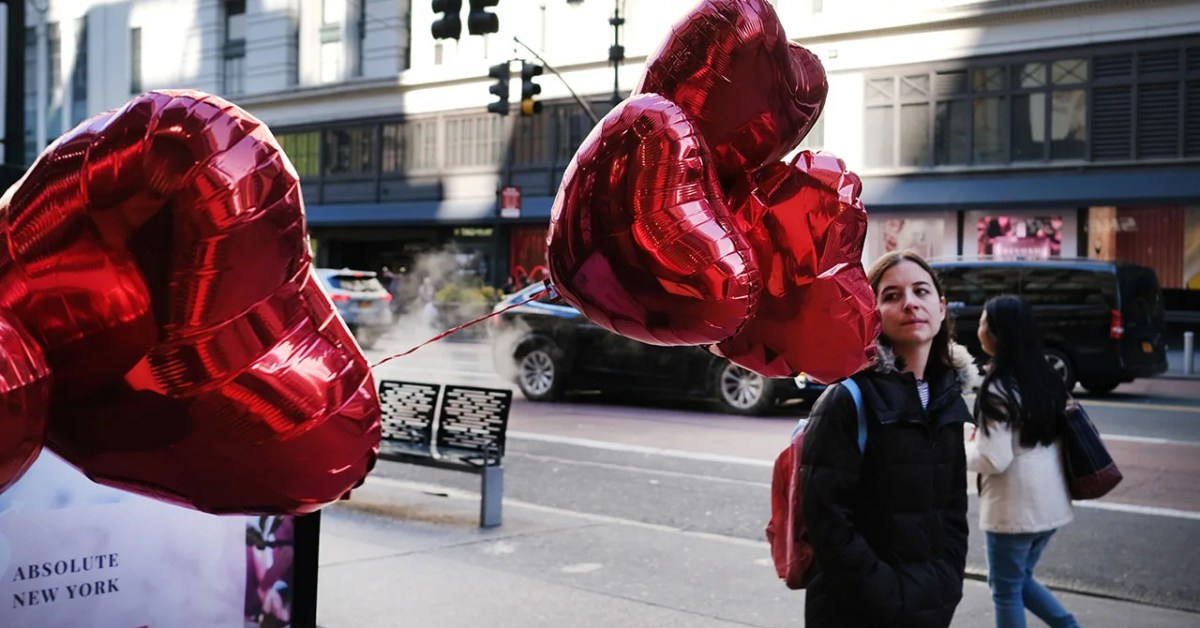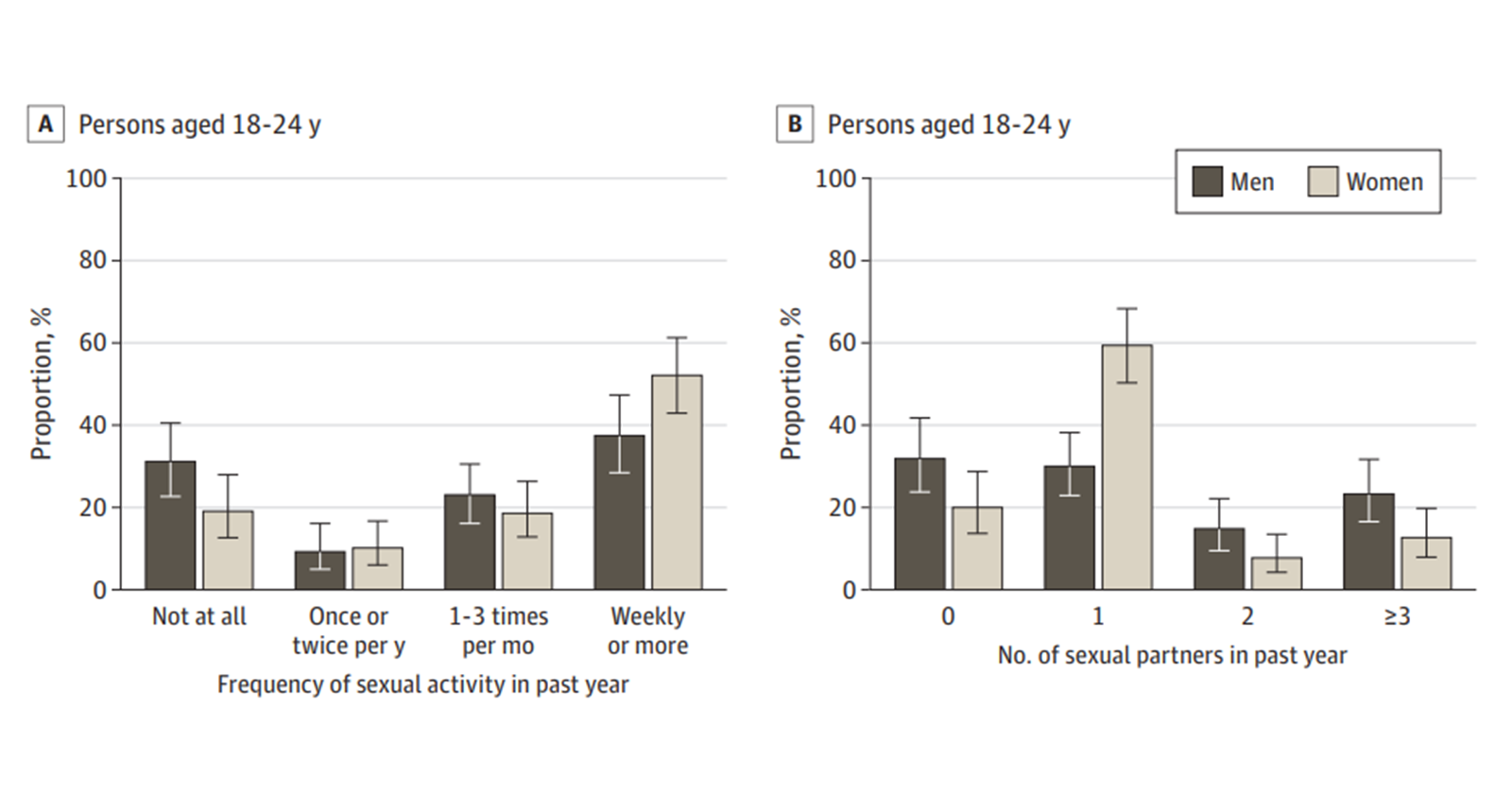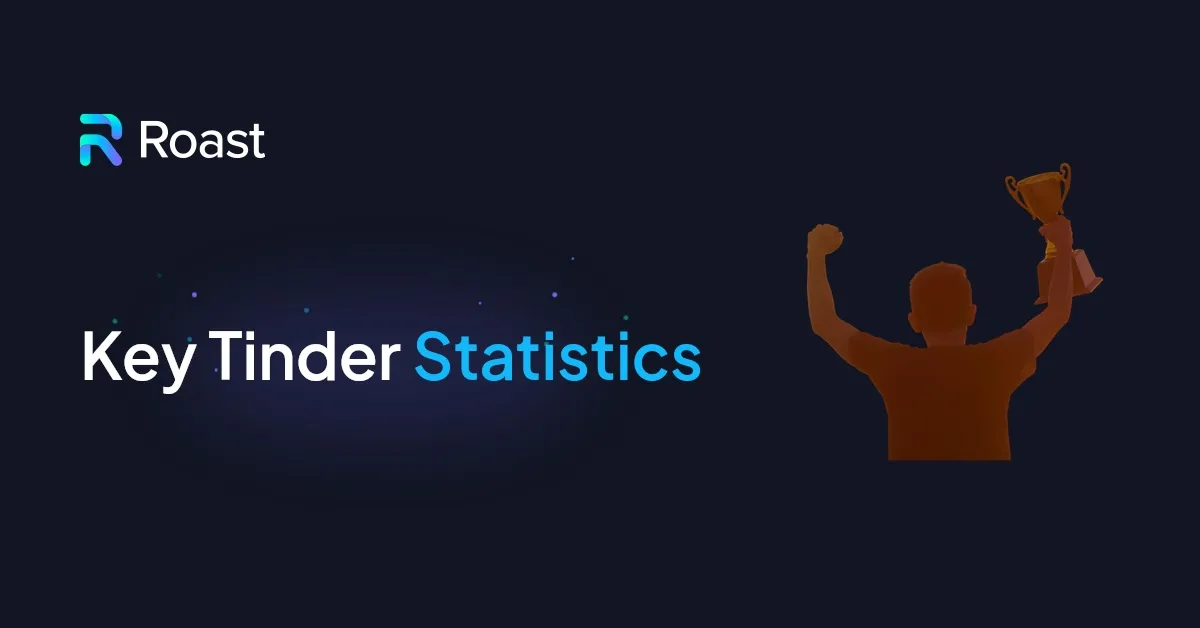ResidentHell
Veteran
★★
- Joined
- Jul 30, 2022
- Posts
- 1,171
The current state of sex / relationship market for zoomers?
If we look at the most recent stats for zoomer sexual lifestyle, it can be simplified by these points:

 www.pewresearch.org
www.pewresearch.org

 jamanetwork.com
jamanetwork.com
If you extrapolate from the zoomer sex life stats, you can make the following conclusions:
Now this leads us to two questions:
If we assume that females are not bothered by the fact that they are likely to be involved in “harems” centred around a single man, and assume the majority of zoomer males are bothered by their low rates of sexual contact with females, this leads to a new question:
Why are the majority of zoomer males either sexless or “not having enough sex” even while they want to have sexual relations with females?
There are two potential answers to this question – The “non-incel” answer of "Personality" and the “incel” answer of "Genetics"
The “non-incel” answer summarised by the “Personality Argument”:
Your personality sucks. You are a misogynist and your personality is toxic. For this reason, any woman you come across will probably dislike you. This combination of abstract and subjective factors, ultimately places you below the minimum standard for a male to be sexually attractive enough for other females to let them fuck. In effect, you would be sexless as most if not all women you meet would not consider you a suitable sex partner due to your misogynistic and toxic personality
The “incel” answer summarised by the “Genetics Argument”:
Your genetics suck. Your face is not attractive enough, you are too short (below 6 ft) or/and you have some sort of physiological condition (e.g., missing limbs, receding hairline, inferior facial bone structure) or genetic defect (e.g., dwarfism, microcephaly). This combination of physiological and genetic factors, ultimately places you below the minimum standard for a male to be sexually attractive enough for other females to let them fuck. In effect, you would be sexless as most if not all women you meet would not consider you a suitable sex partner due to your physiological handicaps or/and genetic inadequacy
Which leads to a new question, which argument is closer to the truth…
The “non-inkwell” explanation or the “inkwell” explanation; the Personality Argument or Genetics Argument?
AFAIK, there’s not enough hard data to support the “Personality Argument”, but I have seen data on dating app interactions that seems to correlate with the “Genetics Argument”. I want to be as objective as I can be about this subject. If you have any research data that supports either of the two arguments, you can add them in the replies
Summary of Dating App Stats for Gen Z and Millenials
According to Pew Research Center, 53% of US adults between ages 18 to 29 (mostly Gen Z) have used a dating app before. This report was from February 2023, which is barely under year ago. For anyone who says “dating apps aren’t real life”, well if you look at the stats: A slight majority, but still a majority, of Gen Z and late millennials in the USA have used a dating app before. If a majority of Gen Z and late millennials from the USA have used a dating app before, I’d say dating apps are more likely to reflect “real life” than any other method of searching for relationships or casual sex (at least for zoomers and millennials) in the USA. Also there was another source somewhere which stated the most common ways that couples met each other was by their place of work/school, mutual friends or dating apps, but I haven't located the source. If I find it, I may add in the replies
Then again, it’s claimed the Tinder user ratio of male to female is 3:1, which means most active users on Tinder are male, although I’m unsure about the male to female ratio for other dating apps. We could assume most dating app users are male, and that a minority of dating app users are female. But then again, other social media services can be considered “pseudo-dating apps”, like Instagram, Facebook, Snapchat. It’s possible that females who don’t use conventional dating apps like Tinder or Bumble, use other social media services like Instagram or Snapchat to search for potential sex partners
Adding to that, Tinder and Bumble are the most popular dating apps among Gen Z and late millennials. Among the Gen Z and late millennials who use dating apps, 79% of them use Tinder and 51% use Bumble

 www.pewresearch.org
www.pewresearch.org
As most Gen Z and millennials on dating apps use Tinder, let’s look at Tinder stats… It can be summarized by this list of points:

 mazeoflove.com
mazeoflove.com

 roast.dating
roast.dating
Do the stats on dating apps support the Genetics Argument?
If you think about it, there’s pretty much nothing to examine on a person’s dating app profile besides their profile picture and bio. It is debatably absurd to think that a personality can be assessed from only a social media bio and profile picture, especially when the bio is restricted to a maximum 200 or 300-character count. So realistically, all that dating app users have to go on before swiping left or right, is a profile picture which would be a display of the genetics of the person in question
It’s clear as day that dating app stats (at least on Tinder) for men and women are incongruent to a degree that women have a much easier time being validated on dating apps. The real question is why do women have more success with dating apps? You might say it’s because the amount of women on dating apps is lower than men, which means you should expect women to be unfairly represented in every dating app statistic. This is a fair point, but then again, the ratio of men to women is 3 to 1. So if women are to be unfairly represented in a dating app statistic, then by a fair standard, women should not be over-represented by more than 3x of the stat that represents men in a reciprocal variable, or under-represented by less than 1/3x of the stat that represents men in a linear variable:
It can be debated that both men and women on dating apps are to blame for these over-representations and under-representations of women in dating app stats, but it depends on how you wish to look at it --- Either men swipe right on too many profiles, or women don’t swipe right on enough profiles. Either men like too many profiles, or women don’t like enough profiles
If you ask me, I think men on Tinder swipe right on too many profiles, when you consider that women make up a quarter of Tinder userbase. If men swipe right on more or less than half of all profiles, it means women as the minority gender on dating apps are guaranteed to have an excessive influx of male profiles who want to match with them – So much that they will have too many potential male suitors to choose from. Effectively, a female can be incentivized to practice hypergamy, not because they have strict preferences, but because they have soooo many men who want to date or fuck them, that it wouldn’t even be practical for her to get around to all men who have shown romantic or sexual interest in her, even if she actually wanted to get around to all men who’ve shown interest
Do the stats on dating apps support the Personality Argument?
It’s hard to agree, because women swipe left on virtually all profiles they discover, whereas men swipe left on barely less than half of all profiles they discover. Plus if you consider that women and men swipe on hundreds or thousands of profiles every week, it can be suggested that some male and female users may look at a profile for only a few seconds before swiping in order to save time on the high amount of profiles they discover every week. So, I don’t see how one can effectively determine whether someone has a desirable personality based on only their profile picture or bio after looking at it for a few seconds
If we assume it’s not practical to accurately evaluate someone’s personality from a profile picture and short bio that’s looked at for a few seconds, then we must ask: Why do women swipe left on virtually all profiles they discover on dating apps, while men don’t? I’ll leave you to decide that
The increase in sexless men correlates with the increase in usage of dating apps and social media, but correlation doesn’t necessarily equal causation. Then again I think the truth behind this “sexlessness epidemic” in zoomer and millennial males can be found somewhere in the patterns of social media activity. I think social media is the biggest contributing factor to male sexlessness, but not for the “non-incel” reasons that normies might claim. The “incel” reason for male sexlessness is the number of female users has increased on social media, and in result females became exposed to a variety of high SMV males at a higher rate (via social media) which caused them to have massively inflated preferences for potential male sex partners based on genetic qualities, which only a minority of men can naturally match up to. However it’s hard to show with hard proof that increase in social media activity causes a decline in sexual activeness for men without being exposed to the "non-incel" trope of “male sexlessness can be attributed to spending too much time indoors on social media and video games, and not spending enough time socializing in the outside world”
For me personally, I think the “Genetics Argument” accounts for 90% of the reason why zoomer males are sexless or “not having enough sex”. IMO the genetic preferences of modern women are so immense, that most normies fail to match up to it. I think most women prefer a man who lives up to their genetic preferences with flying colours (aka Chadlite or Chad). Otherwise the male has to be prepared to make economic expenses on the woman to make up for his failure to match her genetic preferences (aka betabux for normies and lower). But I’ll also say the “Personality Argument” accounts for 10% of the reason why zoomer males are “not having enough sex”. IMO personality doesn’t matter to women for the most part, and I think most but not all women would choose “narcissistic and abusive” Chad over “kind and humble” normie if they had to choose one of the two. But personality matters enough that a woman may choose “kind and humble” Chad over “narcissistic and abusive” Chad if they had to choose one of the two
Any other relevant stats or insights may be shared in the replies
If we look at the most recent stats for zoomer sexual lifestyle, it can be simplified by these points:
-- Most male zoomers (>60%) are single. Most female zoomers (<40%) are not single
-- Most male zoomers (>60%) either have sex occasionally (i.e., once every few months, one a year), or don’t have sex at all (i.e., don’t have sex for at least a whole year). Between male zoomers who don’t have sex frequently, around 30% of them have sex at least once a year, and around 30% of them don’t have sex for at least a whole year
-- The other minority of male zoomers (<40%) have sex frequently (i.e., at least once a week, more than once a month)
-- Most female zoomers (between 60% - 80%) have sex frequently. The other minority of female zoomers (between 20% - 40%) either have sex occasionally or don’t have sex at all
-- The excess proportion of zoomer males who have occasional sex or no sex, is higher than the excess proportion of zoomer females who have occasional sex or no sex
-- If you compare zoomer sex life stats to the sex life stats of previous generations, it seems zoomer males have the lowest rates of sexual contact with females, at least out of the past four generations of adult males (Zoomer, Millenial, Gen X, Boomers)

For Valentine’s Day, 5 facts about single Americans
The percentage of single Americans who are looking for a relationship or casual dates is lower than in 2019, especially among men.

Trends in Frequency of Sex and Number of Sexual Partners Among US Adults Aged 18 to 44 Years
This survey study of adults aged 18 to 44 years examines trends in reported frequency of sexual activity and number of sexual partners and the association between measures of sexual activity and sociodemographic variables.
If you extrapolate from the zoomer sex life stats, you can make the following conclusions:
-- If one virgin were to exist between a zoomer male and zoomer female, the zoomer male is more likely to be the virgin
-- It's probable there are more “harems” which have a lesser number of males and a higher number of zoomer girls, than the number of “harems” which have a lesser number of females and a higher number of zoomer males. Basically, female zoomers are more likely to be involved in a “harem” that’s centred around the same man, than male zoomers are likely to be involved in a “harem” that’s centred around the same woman
Now this leads us to two questions:
1. Are females bothered by the fact they are more likely to be involved in a “harem” that has a higher number of women than men? In other words, are women bothered by the fact they as the female sex, are more likely to be involved in a “harem” that has multiple other women who share a smaller group of men?
2. Are the majority of zoomer males bothered by the fact they are more or less in a state of sexlessness?
If we assume that females are not bothered by the fact that they are likely to be involved in “harems” centred around a single man, and assume the majority of zoomer males are bothered by their low rates of sexual contact with females, this leads to a new question:
Why are the majority of zoomer males either sexless or “not having enough sex” even while they want to have sexual relations with females?
There are two potential answers to this question – The “non-incel” answer of "Personality" and the “incel” answer of "Genetics"
The “non-incel” answer summarised by the “Personality Argument”:
Your personality sucks. You are a misogynist and your personality is toxic. For this reason, any woman you come across will probably dislike you. This combination of abstract and subjective factors, ultimately places you below the minimum standard for a male to be sexually attractive enough for other females to let them fuck. In effect, you would be sexless as most if not all women you meet would not consider you a suitable sex partner due to your misogynistic and toxic personality
The “incel” answer summarised by the “Genetics Argument”:
Your genetics suck. Your face is not attractive enough, you are too short (below 6 ft) or/and you have some sort of physiological condition (e.g., missing limbs, receding hairline, inferior facial bone structure) or genetic defect (e.g., dwarfism, microcephaly). This combination of physiological and genetic factors, ultimately places you below the minimum standard for a male to be sexually attractive enough for other females to let them fuck. In effect, you would be sexless as most if not all women you meet would not consider you a suitable sex partner due to your physiological handicaps or/and genetic inadequacy
Which leads to a new question, which argument is closer to the truth…
The “non-inkwell” explanation or the “inkwell” explanation; the Personality Argument or Genetics Argument?
AFAIK, there’s not enough hard data to support the “Personality Argument”, but I have seen data on dating app interactions that seems to correlate with the “Genetics Argument”. I want to be as objective as I can be about this subject. If you have any research data that supports either of the two arguments, you can add them in the replies
Summary of Dating App Stats for Gen Z and Millenials
According to Pew Research Center, 53% of US adults between ages 18 to 29 (mostly Gen Z) have used a dating app before. This report was from February 2023, which is barely under year ago. For anyone who says “dating apps aren’t real life”, well if you look at the stats: A slight majority, but still a majority, of Gen Z and late millennials in the USA have used a dating app before. If a majority of Gen Z and late millennials from the USA have used a dating app before, I’d say dating apps are more likely to reflect “real life” than any other method of searching for relationships or casual sex (at least for zoomers and millennials) in the USA. Also there was another source somewhere which stated the most common ways that couples met each other was by their place of work/school, mutual friends or dating apps, but I haven't located the source. If I find it, I may add in the replies
Then again, it’s claimed the Tinder user ratio of male to female is 3:1, which means most active users on Tinder are male, although I’m unsure about the male to female ratio for other dating apps. We could assume most dating app users are male, and that a minority of dating app users are female. But then again, other social media services can be considered “pseudo-dating apps”, like Instagram, Facebook, Snapchat. It’s possible that females who don’t use conventional dating apps like Tinder or Bumble, use other social media services like Instagram or Snapchat to search for potential sex partners
Adding to that, Tinder and Bumble are the most popular dating apps among Gen Z and late millennials. Among the Gen Z and late millennials who use dating apps, 79% of them use Tinder and 51% use Bumble

From Looking for Love to Swiping the Field: Online Dating in the U.S.
Tinder is the most widely used dating platform in the U.S. About half of those who have used dating sites or apps have had positive experiences, and some have met their partners on one; however, safety and harassment remain issues.
As most Gen Z and millennials on dating apps use Tinder, let’s look at Tinder stats… It can be summarized by this list of points:
Men swipe right on 53% of profiles, which is over 1 in every 2 discovered profiles, and women swipe right on 5% of profiles, which is 1 in every 20 discovered profiles. It means men are about 10x more likely than women to swipe right on any Tinder profile they discover
Men have a match rate of 1.8% on right swipes, and women have a 36% match rate on right swipes. It means women are 20x more likely than men to match with another Tinder profile that they swiped right on
Men like 1 out of 3 profiles swiped (35%) and women like 1 out of 16 profiles swiped (6%). Men receive 1 match per 40 profile likes (3%), women receive 1 match per 2 profile likes (45%). Basically, men are 6x more likely than women to like a Tinder profile, and women are 15x more likely than men to receive a match for every profile they like
63% of Tinder revenue comes from the USA, followed by the UK (12%), then France (12%), Germany (5%) and Canada (5%). Only 14% of Tinder users have paid for services on Tinder. According to the source (Roast Dating), “Tinder is not pay to win”, “you don’t necessarily have a better experience on Tinder by having more money” and “it’s all about your personality”
The vast majority of Tinder users are from the USA (43%), UK (12%), France (8%), Brazil (22%) and Canada (10%)

Tinder Statistics in [current_year] (Latest Users & Swipe Data) | Maze of Love
Tinder is by far the most popular dating app in the world.
 mazeoflove.com
mazeoflove.com

Tinder statistics 2025: All you need to know about the dating app!
Step into Tinder's world, where love intertwines with data. Explore the intriguing statistics behind swipes and matches. Whether a Tinder user or a data enthusiast, this piece offers a fascinating insight into the heart of digital dating
Do the stats on dating apps support the Genetics Argument?
If you think about it, there’s pretty much nothing to examine on a person’s dating app profile besides their profile picture and bio. It is debatably absurd to think that a personality can be assessed from only a social media bio and profile picture, especially when the bio is restricted to a maximum 200 or 300-character count. So realistically, all that dating app users have to go on before swiping left or right, is a profile picture which would be a display of the genetics of the person in question
It’s clear as day that dating app stats (at least on Tinder) for men and women are incongruent to a degree that women have a much easier time being validated on dating apps. The real question is why do women have more success with dating apps? You might say it’s because the amount of women on dating apps is lower than men, which means you should expect women to be unfairly represented in every dating app statistic. This is a fair point, but then again, the ratio of men to women is 3 to 1. So if women are to be unfairly represented in a dating app statistic, then by a fair standard, women should not be over-represented by more than 3x of the stat that represents men in a reciprocal variable, or under-represented by less than 1/3x of the stat that represents men in a linear variable:
If men match with 1.8% of all right-swiped profiles, the stat for women by a fair standard shouldn’t be more than 5.4%, but it’s 36%. That’s almost 7x higher than what would be the fair amount for women on dating apps
If men swipe right on nearly half of all profiles (53%), women shouldn’t swipe right on less than 17% to 18% of profiles, but they swipe right on only 5%. That’s about 3x lower than what would be the fair amount for women on dating apps
If the ratio of matches to profile likes for men is 3%, the stat for women by a fair standard shouldn’t be more than 9%, but it’s 45%. That’s 5x higher than what would be the fair amount for women on dating apps
If men like 1 out of 3 profiles (35%), women by a fair standard shouldn’t like less than 1 out of 9 profiles (11% - 12%), but its 1 out of 16 profiles (6%). That’s about 2x lower than would be the fair amount for women on dating apps
It can be debated that both men and women on dating apps are to blame for these over-representations and under-representations of women in dating app stats, but it depends on how you wish to look at it --- Either men swipe right on too many profiles, or women don’t swipe right on enough profiles. Either men like too many profiles, or women don’t like enough profiles
If you ask me, I think men on Tinder swipe right on too many profiles, when you consider that women make up a quarter of Tinder userbase. If men swipe right on more or less than half of all profiles, it means women as the minority gender on dating apps are guaranteed to have an excessive influx of male profiles who want to match with them – So much that they will have too many potential male suitors to choose from. Effectively, a female can be incentivized to practice hypergamy, not because they have strict preferences, but because they have soooo many men who want to date or fuck them, that it wouldn’t even be practical for her to get around to all men who have shown romantic or sexual interest in her, even if she actually wanted to get around to all men who’ve shown interest
Do the stats on dating apps support the Personality Argument?
It’s hard to agree, because women swipe left on virtually all profiles they discover, whereas men swipe left on barely less than half of all profiles they discover. Plus if you consider that women and men swipe on hundreds or thousands of profiles every week, it can be suggested that some male and female users may look at a profile for only a few seconds before swiping in order to save time on the high amount of profiles they discover every week. So, I don’t see how one can effectively determine whether someone has a desirable personality based on only their profile picture or bio after looking at it for a few seconds
If we assume it’s not practical to accurately evaluate someone’s personality from a profile picture and short bio that’s looked at for a few seconds, then we must ask: Why do women swipe left on virtually all profiles they discover on dating apps, while men don’t? I’ll leave you to decide that
The increase in sexless men correlates with the increase in usage of dating apps and social media, but correlation doesn’t necessarily equal causation. Then again I think the truth behind this “sexlessness epidemic” in zoomer and millennial males can be found somewhere in the patterns of social media activity. I think social media is the biggest contributing factor to male sexlessness, but not for the “non-incel” reasons that normies might claim. The “incel” reason for male sexlessness is the number of female users has increased on social media, and in result females became exposed to a variety of high SMV males at a higher rate (via social media) which caused them to have massively inflated preferences for potential male sex partners based on genetic qualities, which only a minority of men can naturally match up to. However it’s hard to show with hard proof that increase in social media activity causes a decline in sexual activeness for men without being exposed to the "non-incel" trope of “male sexlessness can be attributed to spending too much time indoors on social media and video games, and not spending enough time socializing in the outside world”
For me personally, I think the “Genetics Argument” accounts for 90% of the reason why zoomer males are sexless or “not having enough sex”. IMO the genetic preferences of modern women are so immense, that most normies fail to match up to it. I think most women prefer a man who lives up to their genetic preferences with flying colours (aka Chadlite or Chad). Otherwise the male has to be prepared to make economic expenses on the woman to make up for his failure to match her genetic preferences (aka betabux for normies and lower). But I’ll also say the “Personality Argument” accounts for 10% of the reason why zoomer males are “not having enough sex”. IMO personality doesn’t matter to women for the most part, and I think most but not all women would choose “narcissistic and abusive” Chad over “kind and humble” normie if they had to choose one of the two. But personality matters enough that a woman may choose “kind and humble” Chad over “narcissistic and abusive” Chad if they had to choose one of the two
Any other relevant stats or insights may be shared in the replies
Last edited:






